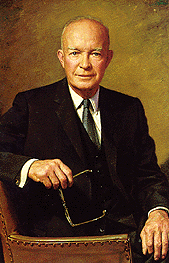
Rosser Reeves -The HARD Sell -USP (Unique Selling Proposition) SELLING a Presidential Candidate |
 |
During the 1950’s there was a fear that an H bomb would be dropped. People built bomb shelters, and had air-raid drills. Science fiction movies showed detonated bombs destroying civilization. Joseph McCarthy gained worldwide attention when he charged that the U. S. government was filled with Communists. The time became known as the "Red Scare." The public was ready for a hero.
In 1952 the Republicans needed a candidate to run for president. They wanted Dwight David Eisenhower (Ike). He had commanded the Allied Forces landing in North Africa in November 1942; on D-Day, 1944, he was Supreme Commander of the troops invading France. After the war, he became President of Columbia University, then took leave to assume supreme command over the new NATO forces being assembled in 1951. Republican emissaries were sent to his headquarters near Paris to persuade him to run for President in 1952. However, Eisenhower refused to run; he wasn't a politician. He said, "Why can't a solider just do his duty." The Republicans' "calling" became too strong, and he gave in and decided to run. |
 |
BBD&O (Batton, Barton, Durstine and Osborn) had been a Republican firm. They decided that they needed to recast Ike. He was stiff and awkward and TV lighting made him look old. BBD&O decided to take control of every appearance. The campaign theme would be "Ike the returning hero." He wasn't a politician so images would be all important . Democratic candidate Adelaide Stevenson was an eloquent speaker and they knew Ike could not compete. Ike's appearances would all be scripted. As he arrived flags would wave, the crowd would cheer, Ike would enter the hero. Thus began TVs impact as a force in American politics.
Rosser Reeves of the Ted Bates Agency was assigned to work on Ike's television spots. Rosser was not a politician but he became one of the most influential men behind the political scene in 1952.
Rosser Reeves introduced the television spot- in quick, out quick and done. Reeves believed in the USP- the unique selling proposition- one theme. Reeves did not overestimate the intelligence of his audience. They would spend $2 million dollars in the last three weeks of the campaign on television spots. The election was to be close. The spots could target the undecided voters; they would be scripted so there would be no chance for the candidate to slip up and in the last three weeks there would be no chance for the Democrats to answer.
Reeves went through all the press clippings of what Ike had said and decided he was all over the map and he needed one theme. Reeves picked three themes ( Ike cleans up corruption; Ike soldier but man of peace; Ike cleaning up Communists) and sent them out to in 3 mailings to 10,000 Reader's Digest Readers asking them which theme they preferred. The results showed people liked the peace angle and "Eisenhower, man of peace" was chosen.
Reeves wrote about 20 spots, and had Eisenhower come to the studio for one day. Eisenhower did not like the idea that he was being orchestrated, but reluctantly went along. They didn't want him to look old so he was forced to read off large cards without his glasses. Reeves then went to find the typical Americans who would ask Ike the questions that went with one of the set responses. The primitive spots were put together. They showed Ike as the good ordinary American.
The Democrats were furious and complained that the Republicans had, "invented a new kind of campaign--conceived not by men who want us to face the crucial issue of the day, but by the high-power hucksters of Madison Avenue. (George Ball, Democratic speech writer). Others complained that they were selling the president like they would toothpaste.
Although he was a natural speaker, Adelaide Stevenson refused to pay attention to the medium of television. He didn't watch TV. He appealed to the intellectuals and journalists. While Eisenhower obviously had no political experience, he appealed to the common man especially after the work of BBD&O and Rosser Reeves!
Eisenhower won a sweeping election victory.
source: Halberstam, David. The Fifties. New York: Random House. 1993.